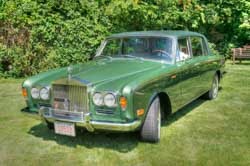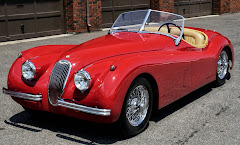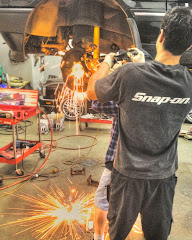It looks beautiful on the outside . . . .
But what about under the hood?
That’s where this car shows its forty-some years. There’s no rust or corrosion, and no damage,
but everything looks tired. This car is better than 95% of its peers, but still . . . Even when
clean, the engine bay never really looks good.
The rubber is faded and spotty.
Paint has begin flaking from stress points in the fender wells, and
there are chips on the painted parts of the engine.
 |
| Stress cracks and aging in the inner fender wells |
Cad-plated pipes have aged unevenly. The painted silver intake has lost its gloss, and acquired a permanent tint of grease, New service parts stand out against a
background of age. Under everything
there is the engine long block, covered by a patina of hardened grease and
grime.
This is the situation for most pre-1994 Rolls Royce and
Bentley motorcars. It actually applies
to later cars too, but the appearance of plastic covers in 1994 hides the
problem from casual viewers. The
complexity of these engine compartments makes it almost impossible to keep them
truly sparkling. Even cars with show-winning
paint and interior usually fall short when the hood is opened.
Most owners address this issue by keeping the hood
closed. But what if you want the engine
area to look as good as the rest of the car?
You restore it, just as you would any other component or system. That’s what we are doing here . . .
 |
| Master Technician Robert Toti prepares the engine for removal |
We started by making a plan.
We knew the inner fenderwells needed paint work, and that could not be
done with the motor in the car.
Underneath, the subframe and suspension members really show their
age. There’s only so much you can do to
clean them up, with a motor in place.
We began by removing the driveshaft and transmission to facilitate
engine removal.
Next, we removed the engine in order to address its problems on the
bench. This motor will be restored
internally as well as cosmetically. We
will address leakage from the liners, and all the accumulated wear. Engine removal revealed a number of problems
– wear in the cam lobes for the hydraulic pumps; a crumbling steering coupler;
and a cracked exhaust manifold.
 |
| A crumbling rubber steering coupler, hidden by the engine |
All that
will be fixed to a better-than-new standard.
 |
| The Rolls Royce long block out of the car |
The disassembly we’ve done revealed more hidden issues in the
hydraulics so this car will get its pumps, accumulators, and valves
rebuilt. Luckily those parts are still
available.
 |
| Brake fluid leakage has turned the silver engine block finish greenish |
We’ll send hundreds of little bits out for refinishing – cad
plating, zinc plating, powder coating in silver or black, ceramic coating, etc. There’s no other way to do a repair that
lasts. Most of these parts (brackets,
throttle rods, etc) are not subject to wear but they have suffered cosmetically
and they make up most of what you see, as you look under the hood.
The "easy way out" would be to spray paint all these parts just as you see them (hopefully after they were cleaned.) I see that done all too often, even in so-called professionally restored cars. But the fact is, these parts were not painted spray can silver when new, and that kind of finish won't last. Nor will it hold up to close inspection.
Refinishing the pieces individually, and then putting them together, is the job that lasts. It's also the job that matches how the factory did it and offers the chance to truly do it better than new.
The "easy way out" would be to spray paint all these parts just as you see them (hopefully after they were cleaned.) I see that done all too often, even in so-called professionally restored cars. But the fact is, these parts were not painted spray can silver when new, and that kind of finish won't last. Nor will it hold up to close inspection.
Refinishing the pieces individually, and then putting them together, is the job that lasts. It's also the job that matches how the factory did it and offers the chance to truly do it better than new.
 |
| A few of the brackets we'll be refinishing on this motor |
We will clean up and service the transmission and electric
gear selector while they are out of the car.
The GM400 is inexpensive to overhaul so we’ll fit new clutches as well
as new seals.
 |
| The RR stamp on the bellhousing identifies this as an original Rolls gearbox, circa 1972 |
Next we will remove the subframe, strip it down, overhaul,
and refinish it. We will sandblast all
the metal parts and powder coat them in gloss black. Then we will reassemble them with new ball
joints and bushings. That’s the only way
to get a result that both looks and performs as new.
 |
| The engine, mostly stripped to the block |
 |
| Another Rolls Royce short block as rebuilt by our machinists |
While this is underway we will put the car on a wood
subframe and dollies so it can be moved from one area of the shop to
another. We hope to address some
bodywork concerns while the engine bay work progresses.
We will clean up, repair and paint the fender wells and firewall as needed. It’s fairly easy to do that now, with nothing
in the way. We need to move some AC
lines, the AC condenser, and the brake reservoirs out of the way. Those parts
will need refinishing too.
 |
| This Cadillac engine bay is much simpler than the 70s Rolls. It sets a minimum standard for finish quality. |
 |
| A restored XKE engine compartment |
After that, we will assemble the subframe and install the
engine and transmission onto it. This is
how the cars were originally assembled in Crewe.
Using a special stand we will refit the subframe –
powertrain and all – back into the car, and we’ll do the final assembly.
When it’s done, you will be able to open the hood and see an
engine bay that glitters just as it did in some long-ago Rolls-Royce showroom.
As you can see, this is a major undertaking but it’s what one must do, to bring any modern Rolls-Royce engine compartment up to the
show standards used for pre-1965 cars.
We’ve done a number of older engine bays – which are much simpler under
the hood. We’ve also done simpler cars,
like this BMW 2002. Newer Rolls-Royce/Bentley vehicles are daunting when you
look at them, but the individual tasks are the same as any car – there is just
a lot more to do!
 |
| The BMW engine bay - BEFORE |
 |
| The BMW 2002 engine bay - AFTER |
Some owners will say, Why do it? The fact is, work like this is what makes
true works of automotive art. Look at
the late 50s Cadillacs or Chevies . . . Those cars were once treated like
Shadows and Wraiths are today. They
looked good on the outside, but underneath they were old and tired. That was good enough for the collectors of
the 80s, many of whom were do-it-yourself hobbyists. Then a new group of enthusiasts came on the
scene. These guys had experience with high-end
restorations on old cars, and they applied those techniques to the domestic
cars of the fifties. Auction prices of
those cars soared – 1000% or more in some cases – and the top models command
strong six-figure prices at auction today.
Clearly, that would not happen if you opened the hood to see
wear, rust, dirt and grime.
Will work like this transform the Rolls-Royce market? That’s a good question. Here at Robison Service we are asked to do more
and more restoration of cars from the 70s 80s and even 90s. That work goes well beyond regular upkeep,
and puts those cars head and shoulders above their unrestored brethren. What will happen when these vehicles begin
finding their way to auction? I suspect
prices will rise, just as they have with more common marques. Will they rise as much? Who knows . . . Rolls Royce cars are
certainly less common, but the pool of enthusiasts is smaller too.
The fact is, it takes $150-250,000 to do a first rate
restoration on a late 1950s Cloud. A simpler car like a Thunderbird can cost nearly as much, because the labor to do a body and frame has little to do with the brand badge it carries. Older
cars have considerably higher restoration costs. Newer Rolls Royce cars are more complex to
restore than the Cloud series, and they have the potential to cost more. However you feel about that, it is
reality. That will eventually be
reflected in the trading prices for these vehicles as we move from a market
where most cars offered for sale are unrestored to a market where most examples
are restored.
That’s the case now, with older vehicles. For them, restoration is the rule – not the
exception - and price is set by the quality of the restoration and the rarity
of the particular example.
We are just beginning what I call a thinning-out period for
the Shadow and its derivatives. Most
examples are unrestored; they are merely maintained to various degrees. Every year, the rougher units are scrapped as
repair costs overwhelm under-financed or under-committed owners. It is inevitable that we will reach a point
where some numbers of the Shadow-series cars on the road are properly
restored. When that happens their owners
will expect a reasonable return on their investment.
It’s something for any of you to think about, as these cars
age. Restoration is one of those things
that will not decrease in cost with the passage of time. For those of you who own other makes of car, remember that the ideas in this story apply to any newer V8 automobile. A person who chose to restore the engine bay of a Mercedes 6.9 would face many of these same issues, as would someone doing a 1976 Cadillac Eldorado.
Follow the blog as we progress through this job over the
coming winter. You can read Installment Two here. We’ll post regular
updates and we’re happy to answer questions.
John Elder Robison is
the general manager of J E Robison Service Company, independent Rolls Royce and
Bentley specialists in Springfield, Massachusetts. John is a longtime technical consultant to
the RROC and he’s owned and restored many of these fine vehicles. Find him online at www.robisonservice.com or in the real
world at 413-785-1665






























No comments:
Post a Comment